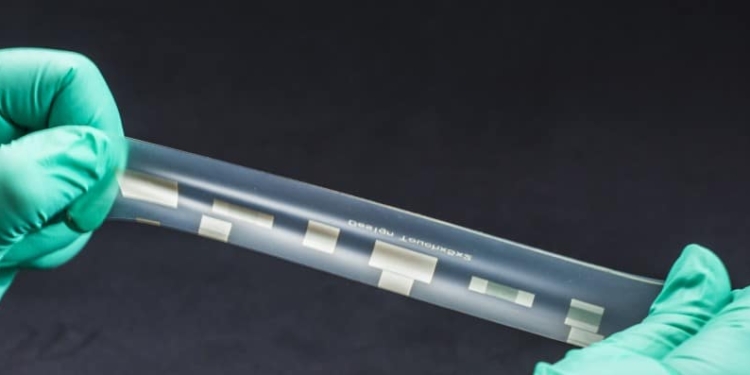source: INM news
15. April 2016
The research scientists at INM have succeeded in manufacturing circuit paths on thin, elastic foil made of silicone. Since these are relatively insensitive to compression and elongation strain, the electrical circuits can adapt to the curvature of appliances.
Industry and product designers have a strong interest in being able to install electrical circuits such as display elements or operating controls even on the shaped surfaces of electronic appliances. Now, in the Optical Materials department at INM – Leibniz-Institute for New Materials, this aim has come one step closer. The research scientists have succeeded in manufacturing circuit paths on thin, elastic foil made of silicone. Since these are relatively insensitive to compression and elongation strain, the electrical circuits can adapt to the curvature of appliances.
In future, it will therefore be possible to put console elements or touch sensitive displays on the ergonomically shaped handles of small electrical appliances and household appliances or console elements. Gestures such as lightly touching or wiping the surface still function reliably although the surface is not planar. As a result, in future, conventional buttons, keys or switches will not be necessary.
The researchers have now achieved the possibility of such electronic switching on elastic material on silicone foil using a process known as photochemical metallization. In this process, colorless silver compounds are transformed into electrically conductive silver when a photoactive layer is irradiated by UV light.
Peter William de Oliveira, Head of INM’s program division Optical Materials explains, “First, the silicone foils are coated with a photoactive layer of metal oxide nanoparticles. After that, we apply a specially developed fluid containing colorless silver ions”.
When this sequence of layers is irradiated with UV light, the silver compound disintegrates on the photoactive layer and the silver ions are reduced to form metallic, electrically conductive silver.
By the use of adjustable pattern, the UV irradiation can be controlled. So, paths or other structures on the carrier material are reduced to form silver. In this way, very narrow conductor paths with widths down to only a few micrometers can be produced on the silicone foil. The electronic circuitry is then transparent to the observer.
Until now, researchers have been able to apply this combination of materials in laboratory format in postcard size. In future, developers would like to extend this manufacturing principle in cooperation with interested partners from industry into a roll-to-roll process. This would make allow a fast, economical and environmentally-friendly manufacturing also in large dimensions including in large formats.
INM conducts research and development to create new materials – for today, tomorrow and beyond. Chemists, physicists, biologists, materials scientists and engineers team up to focus on these essential questions: Which material properties are new, how can they be investigated and how can they be tailored for industrial applications in the future? Four research thrusts determine the current developments at INM: New materials for energy application, new concepts for medical surfaces, new surface materials for tribological systems and nano safety and nano bio. Research at INM is performed in three fields: Nanocomposite Technology, Interface Materials, and Bio Interfaces.
INM – Leibniz Institute for New Materials, situated in Saarbrücken, is an internationally leading centre for materials research. It is an institute of the Leibniz Association and has about 220 employees.































